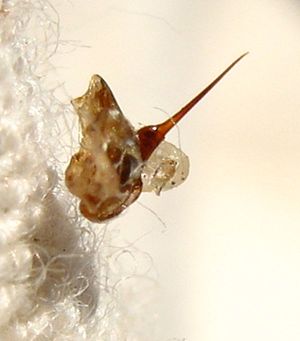Bee sting
| Bee sting | |
|---|---|
 |
|
| The stinger of a black honey bee, torn from the bee's body and attached to a protective dressing | |
| Classification and external resources | |
| Specialty | Emergency medicine |
| ICD-10 | T63.4, X23 |
| ICD-9-CM | 989.5, E905.3 |
| MeSH | D007299 |
A bee sting is a sting from a bee (honey bee, bumblebee, sweat bee, etc.). The stings of most of these species can be quite painful, and are therefore keenly avoided by many people.
Bee stings differ from insect bites, and the venom or toxin of stinging insects is quite different. Therefore, the body's reaction to a bee sting may differ significantly from one species to another. In particular, bee stings are acidic, whereas wasp stings are alkali. So the body's reaction to a bee sting may be very different than to that of a wasp sting.
The most aggressive stinging insects are vespid wasps (including bald-faced hornets and other yellow jackets) and hornets (especially the Asian giant hornet). All of these insects aggressively defend their nests.
Although for most people a bee sting is painful but otherwise relatively harmless, in people with insect sting allergy, stings may trigger a dangerous anaphylactic reaction that is potentially deadly. Honey bee stings release pheromones that prompt other nearby bees to attack.
A honey bee that is away from the hive foraging for nectar or pollen will rarely sting, except when stepped on or roughly handled. Honey bees will actively seek out and sting when they perceive the hive to be threatened, often being alerted to this by the release of attack pheromones (below).
Although it is widely believed that a worker honey bee can sting only once, this is a partial misconception: although the stinger is in fact barbed so that it lodges in the victim's skin, tearing loose from the bee's abdomen and leading to its death in minutes, this only happens if the skin of the victim is sufficiently thick, such as a mammal's. Honey bees are the only hymenoptera with a strongly barbed sting, though yellow jackets and some other wasps have small barbs.
...
Wikipedia
